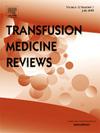Ultra-Restrictive Transfusion Thresholds in Critically Ill Adults: Are We Ready for the Next Step?
IF 2.5
2区 医学
Q2 HEMATOLOGY
引用次数: 0
Abstract
Anemia is almost universal in critically ill patients, with 25% receiving blood transfusions as clinicians aim to prevent insufficient oxygen delivery. The current 'restrictive' hemoglobin (Hb) threshold of 7 g/dL for the nonbleeding critically ill population is supported by several landmark transfusion trials. While some trials have investigated lower transfusion thresholds, these were not conducted in this specific population. Transfusion is associated with various risks including transfusion-associated circulatory overload, transfusion-related acute lung injury, and hemolytic reactions. Moreover, transfusion products are scarce and expensive as they are produced from voluntary blood donations. Therefore, it is essential to limit blood transfusion to when absolutely necessary. Research indicates that several patient categories tolerate lower Hb levels than 7 g/dL. For instance, studies on acute hemodilution in healthy volunteers have shown that lower Hb levels do not lead to organ ischemia. Similarly, studies involving patients who refuse transfusions, often report lower Hb levels down to 5g/dL or less. These lower Hb levels appear to have limited impact on mortality or morbidity related outcomes. In patients with severe burns or hematological disorders, Hb levels below 7 g/dL are not associated with significant adverse outcomes. These findings suggest that the transfusion threshold for critically ill patients could potentially be lowered, as Hb levels under 7 g/dL do not inherently lead to increased mortality or morbidity. An individualized approach to deciding whether to transfuse or not might be best. This shift in transfusion practice could help reduce costs and minimize the risks associated with blood transfusions.
危重成人的超限制性输血阈值:我们准备好下一步了吗?
贫血在危重患者中几乎是普遍的,25%的患者接受输血,因为临床医生的目的是防止氧气输送不足。目前,无出血危重患者的“限制性”血红蛋白(Hb)阈值为7 g/dL,这得到了几项具有里程碑意义的输血试验的支持。虽然一些试验研究了较低的输血阈值,但这些试验并未在这一特定人群中进行。输血与多种风险相关,包括输血相关的循环负荷、输血相关的急性肺损伤和溶血反应。此外,输血产品稀缺且昂贵,因为它们是由自愿献血生产的。因此,在绝对必要的情况下限制输血是必要的。研究表明,一些患者类别可以耐受低于7 g/dL的Hb水平。例如,对健康志愿者急性血液稀释的研究表明,较低的Hb水平不会导致器官缺血。同样,涉及拒绝输血的患者的研究通常报告Hb水平降至5g/dL或更低。这些较低的Hb水平似乎对死亡率或发病率相关结果的影响有限。在严重烧伤或血液系统疾病患者中,Hb水平低于7 g/dL与显著不良结局无关。这些发现表明,危重患者的输血阈值可能会降低,因为Hb水平低于7 g/dL并不必然导致死亡率或发病率增加。个体化的方法来决定是否输血可能是最好的。输血实践的这一转变有助于降低成本并最大限度地减少与输血相关的风险。
本文章由计算机程序翻译,如有差异,请以英文原文为准。
求助全文
约1分钟内获得全文
求助全文
来源期刊

Transfusion Medicine Reviews
医学-血液学
CiteScore
11.60
自引率
0.00%
发文量
40
审稿时长
21 days
期刊介绍:
Transfusion Medicine Reviews provides an international forum in English for the publication of scholarly work devoted to the various sub-disciplines that comprise Transfusion Medicine including hemostasis and thrombosis and cellular therapies. The scope of the journal encompasses basic science, practical aspects, laboratory developments, clinical indications, and adverse effects.
 求助内容:
求助内容: 应助结果提醒方式:
应助结果提醒方式:


